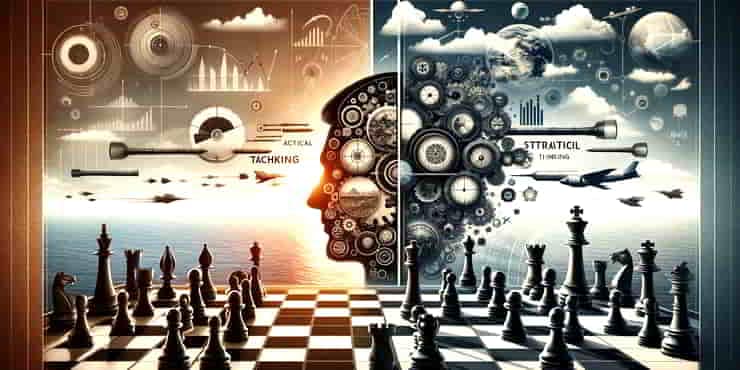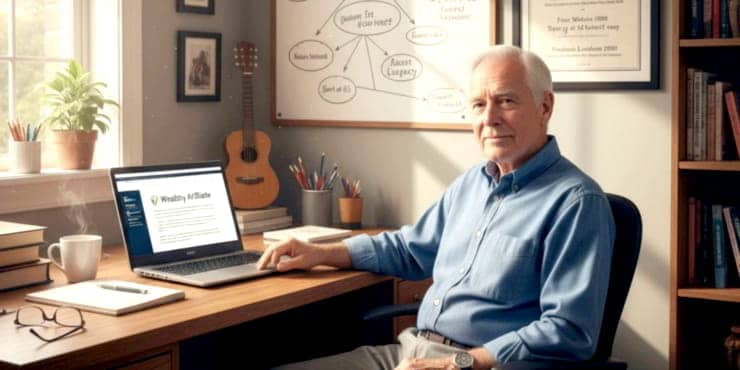Tactical Thinking vs Strategic Thinking: Balancing Short-term Action And Long-term Planning

Estimated reading time: 6 Min
Sustainable success and fulfilment: master the balance between tactical thinking vs strategic thinking. Living in the now while planning for the future.
Imagine the following difficult balance: you’re at the helm of a ship, and the sea stretching before you is vast and unpredictable.
In one moment, you’re navigating through a sudden squall. Decisions need to be as swift as the wind that fills the sails.
In the next, you’re charting a course for distant shores; the success of your voyage depends on foresight and preparation.
This, in essence, reflects the art of balancing immediate actions with strategic thinking, a skill as important in business, personal development, and life in general as it is on the high seas.
The importance of this balance cannot be overstated.
Lean too heavily on immediate actions, and you may find yourself adrift, lost to the whims of short-term challenges.
On the other hand, you run the risk of becoming overwhelmed by the storms that are right outside your door if you focus too much on the far horizon.
The Essence of Immediate Actions
Immediate actions are the decisions and steps taken in response to the present moment’s challenges and opportunities.
They’re the quick adjustments made to keep the ship steady as it encounters unforeseen waves.
These actions are vital for addressing pressing issues that, if ignored, could escalate into larger problems or result in missed opportunities.
Benefits:
- Immediate actions allow for quick responses to threats, ensuring survival and stability.
- They enable the realisation of fleeting opportunities that could lead to greater successes.
Risks:
- An overemphasis on the immediate can lead to short-sightedness, where long-term goals are neglected in favour of short-term gains.
- It can also result in a reactive rather than proactive stance, where decisions are made in a state of constant crisis management.
Mini Case Study
Consider a tech start-up rapidly deploying a software patch to address a sudden security vulnerability.
This immediate action prevents data breaches, maintaining customer trust. However, solely focusing on such fixes without developing a robust, long-term security strategy could leave the start-up vulnerable to future threats.
The Art of Strategic Thinking
Strategic thinking, in contrast, is the compass guiding the ship towards its ultimate destination.
It involves setting long-term goals and developing plans to achieve them, anticipating future challenges and opportunities, and preparing accordingly.
Benefits:
- Strategic thinking provides direction and purpose, ensuring that every immediate action contributes towards a larger vision.
- It helps in identifying and focusing resources on areas of greatest potential impact, enhancing efficiency and effectiveness.
Pitfalls:
- Over-planning without action can lead to paralysis by analysis, where opportunities are lost to indecision.
- There’s also the risk of becoming too rigid in one’s plans, reducing the ability to adapt to unforeseen changes.
Mini Case Study
A retail company develops a five-year strategic plan to expand its online presence and diversify its product range.
This foresight positions the company well when a global event shifts consumer behaviour overwhelmingly towards online shopping, allowing it to thrive while competitors scramble to adapt.
Balancing Tactical Thinking vs Strategic Thinking
Achieving equilibrium between immediate actions and strategic thinking is like a tightrope walker maintaining their balance; it requires concentration, skill, and a keen sense of when to lean one way or the other.
Techniques for assessment:
- Regularly review and adjust plans based on up-to-date information, maintaining a dynamic balance between immediate needs and long-term goals.
- Develop scenarios to anticipate how immediate decisions align with or deviate from strategic objectives.
Strategies for flexibility:
- Foster a culture of agility within teams or personal practices where quick pivots are encouraged and supported as part of strategic execution.
- Develop a portfolio approach to decision-making, allocating resources to both immediate actions and strategic initiatives to spread risk and opportunity.
Real-life analogy: Imagine managing a garden. Daily watering and weeding (immediate actions) are essential for the garden’s health, but so is planning the layout and choosing plants that will thrive in future conditions (strategic thinking).

Balancing the two ensures a garden that is not only vibrant today but will flourish in the years to come.
In weaving together immediate actions and strategic thinking, one crafts a tapestry of decision-making that is both resilient and forward-looking.
The challenge, though complex, is not insurmountable. With the right mindset, tools, and techniques, individuals and organisations can handle the present on their way to thriving in the future.
Tools and Techniques for Effective Balancing
To manage the balance between immediate actions and strategic thinking, one must arm themselves with an arsenal of tools and techniques designed to enhance decision-making processes.
Decision-Making Frameworks
Frameworks such as SWOT (Strengths, Weaknesses, Opportunities, Threats) analysis and the Eisenhower Matrix can help categorise and prioritise tasks and challenges based on their urgency and importance, ensuring that immediate actions are taken with a view to their strategic impact.
Leadership and Communication
Effective leadership is pivotal in maintaining the balance between immediate and strategic considerations.
Leaders must communicate the vision clearly, foster a culture that values both responsiveness and foresightedness, and empower team members to make decisions that align with both short-term necessities and long-term objectives.
Technology and Data
Nowadays, technology and data analytics play a crucial role in supporting balanced decision-making.
Real-time data can inform immediate actions, while predictive analytics can aid in strategic planning, ensuring decisions are data-driven and grounded in reality.
Adaptive Planning
Embrace an adaptive planning approach, where long-term plans are viewed as living documents, reviewed regularly, and adjusted as new information and conditions emerge.
This flexibility ensures that strategies remain relevant and aligned with both current realities and future aspirations.
Case Studies and Lessons Learned
To help crystallise the concepts discussed, here are a couple of case studies of organisations that have mastered the art of balancing immediate actions with strategic thinking.
Case Study 1: A Global Technology Firm
A leading technology firm faced significant disruption in its industry due to emerging technologies.
By balancing immediate actions, such as retraining staff and reallocating resources to R&D, with strategic planning, including investing in start-ups and forming strategic partnerships, the firm not only survived the disruption but also emerged as a market leader.
Flexibility and adaptability, underpinned by a clear strategic vision, are key to turning challenges into opportunities.
Case Study 2: A Non-Profit Organisation
A non-profit grappling with funding cuts implemented immediate measures to reduce expenses and launched a short-term fundraising campaign.
Simultaneously, it developed a long-term strategy focused on diversifying its funding sources and expanding its volunteer base.
Balancing immediate financial sustainability with strategic growth initiatives ensures resilience and longevity.
Summary
The journey through the turbulent waters of immediate action and the vast oceans of strategic thinking brings us to the understanding that balance is not merely desirable but essential for sustained success.
So individuals and organisations must be able to work their way through the present with agility while being guided by a strategic vision of the future.
The art and science of balancing immediate actions with strategic thinking require constant vigilance, a willingness to adapt, and an unwavering commitment to both the journey and the destination.
By employing the right tools and techniques, fostering effective leadership, and learning from those who have successfully navigated these waters before, we can ensure that our ship not only weathers the storm but also reaches the shores of our envisioned future.
Now, I encourage you to reflect on your own balance between the immediate and the strategic.
Consider the tools and techniques discussed, the lessons drawn from those who have charted these waters before, and set sail with confidence, knowing that the balance you strike today will determine the success of your voyage tomorrow.
The opportunities and potential challenges ahead are vast, but with the disciplines of strategic thinking and, at the same time, handling immediate actions, there is no horizon you cannot reach.
There’s no better time than today to make a change, if it’s necessary!
🙂
Richard



![Are Wealthy Affiliate Hubs Revolutionising Website & Content Development In [year]? A futuristic and sleek digital workspace designed for website management and content creation - Wealthy Affiliate Hubs](https://ml0yvzumdtic.i.optimole.com/cb:k6B_.1fa14/w:740/h:370/q:mauto/https://solobusinessmind.com/wp-content/uploads/2024/12/A-futuristic-and-sleek-digital-workspace-designed-for-website-management-and-content-creation-Wealthy-Affiliate-Hubs740x370-O.jpg)


